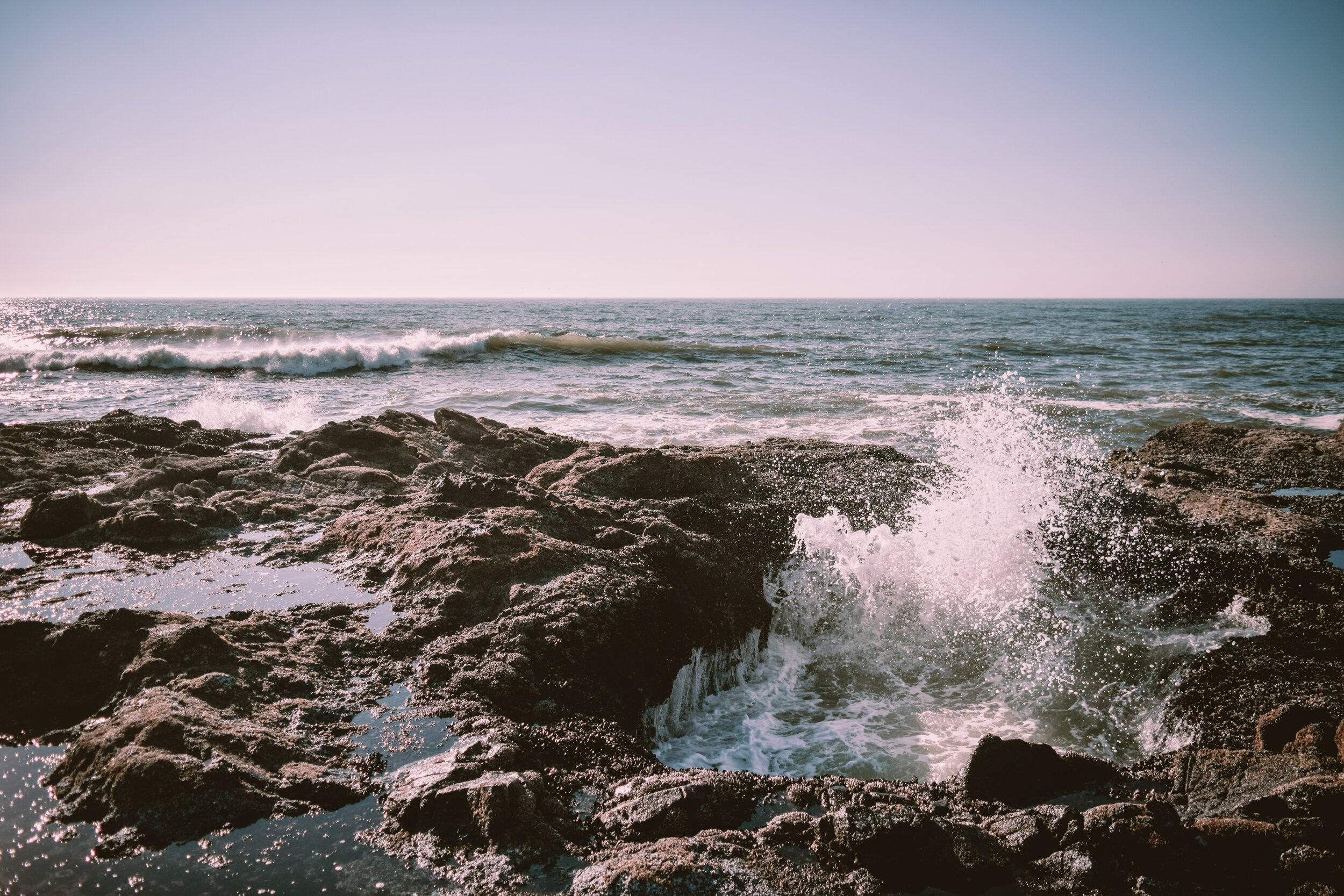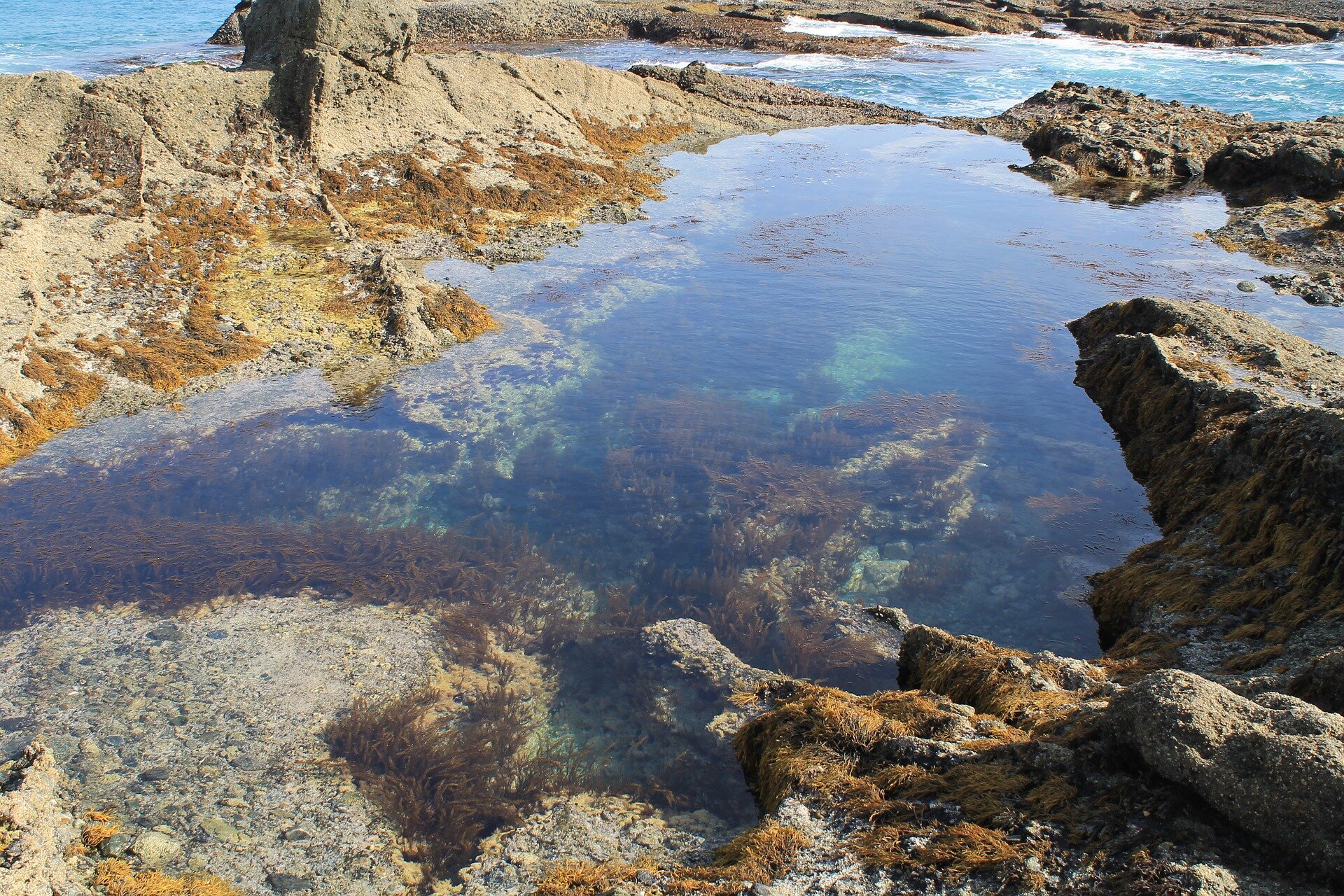It’s a Hard Knock Life: A Look into Rock Pools
Bridget Hott
Whether you know them as tide pools or rock pools, they are usually the first marine ecosystem ocean lovers are introduced to. Becoming exposed at low tide, rock pools are the perfect way to get a glimpse into the miraculous life of the sea without leaving the comfort of the land.
Waves crash on coastal tide pools. Photo: Unsplash.
Each pool is its own microcosm, a mini world filled with incredible life, some of which are permanent residents and others come and go with the tides. While species might be commonly found throughout nearby pools, each pool has its own unique ecology with varying dominant species and available resources.
All tide pools consist of three zones: splash zone, intertidal zone, and subtidal zone.
Splash zone: This zone is the furthest from the ocean, making it the hardest zone to live in. The only water that is present here is the occasional splash or mist from the sea, resulting in extremely harsh conditions like constant sun exposure, high temperatures, increased salinity levels and constant moisture loss. Unsurprisingly, the only life found here is the occasional barnacle and some algae.
Intertidal zone: The intertidal zone lies between the splash zone & the subtidal zone. It’s sort of like the goldilocks zone of rockpools; spending part of the day underwater, and part exposed. Consisting of three regions, this zone has a lot to offer. The high-zone is closest to the splash zone, this is where barnacles, snails, crabs, and the periodic anemone are found. Next is the mid-zone and low-zone, which host more life as deepness, water, food, and shelter increase. It’s more likely to see snails, crabs, sea stars, and more anemones here.
Subtidal zone: The deepest point of a rock pool is the subtidal zone. This area is always covered in water and is where more invertebrates and even fish are found.
Often believed to be sedentary creatures, anemones can actually move around the seafloor to find better positions and safety from predators. Photo: Unsplash.
Life in the Intertidal Zone
Life in the intertidal zone is a bit more difficult than one might imagine. Conditions are almost constantly changing, so organisms that reside here need to be flexible in their requirements and hardy in their responses. Most life is found in the low intertidal zone, which normally remains underwater even when the tide is out.
Some of the aspects that make life easier in the low intertidal zone is that there is almost always abundant food, nutrients, and oxygen as every wave during high tide supplies fresh nutrients and plankton which supports the pool’s food web. There is also abundant algae and plants and ample habitat from all the crevices, rocks, and holes.
What makes life hard for the other areas of a tide pool is the constant change of environmental conditions. For instance, exposure to sunlight easily dries up moisture, increases temperature, decreases oxygen, and changes salinity levels, all variants that dramatically influence life in the oceans. As the tide goes out, life in tide pools is exposed to more predators, such as sea birds, or gets swept out into the open ocean and stranded until the tide comes back in.
However, hard times are what create interesting evolutionary innovations, so the life found in tide pools are some of the scrappiest organisms in the sea. Hard-shelled organisms are able to seal their shells so tightly, they avoid losing any moisture during low tide. Mussels and barnacles cluster together to reduce individual exposure, increasing their protection from predators. Barnacles even have a DIY super-glue mucus, that is actually one of the most powerful glue substances known to man. Researchers are trying to recreate it in the laboratory for commercial use! Some fish, like the sculpin and young opaleyes, have evolved the ability to breathe air, allowing them to survive in oxygen-poor water when the tide is out.
Barnacles huddled together for protection from predators. Photo: Pixabay.
Ecosystem Services from Rock Pools
Rock pools are important ecosystems for a variety of reasons. Tide pools are excellent nursery habitats for juvenile fish and provide coastal protection as well as educational opportunities for people of all ages!
One of the most dynamic services rock pools provide is supporting both oceanic and terrestrial food webs. The combination of algae, seaweed, and a constant influx of nutrients and phytoplankton from the incoming tides means rockpools are loaded with food to support a multitude of organisms. As the plants and microscopic organisms are consumed, the energy eventually travels up the food chain to migratory fish that stop by during high tide and coastal birds that take advantage of the exposure during low tide. Eventually these organisms enter the food web themselves, and the cycle of energy from tide pools has been completed!
Threats to Rock Pools
Unfortunately, tide pools are no exception when it comes to habitat destruction. Like the rest of the ocean, rock pools are susceptible to the damaging side effects of coastal pollution, climate change, coastal erosion, and commercial development. Nearby farms and industrial plants leach chemicals, oil, and other pollutants into the oceans, and the same comes from coastal development for hotels and businesses, causing widespread physical destruction to the habitat itself. Climate change is threatening the life inside tide pools with sea-level rise altering the delicate balance of each pool, ocean acidification and rising temperatures creating unlivable conditions, and strengthening storms bashing the coast and destroying fragile habitats.
A glimpse into the ocean in a large tide pool. Photo: Pixabay.
Take a peak!
Rock pools are an excellent way to get your feet wet and start exploring the ocean, but their ease of access makes the organisms that live inside them very susceptible to human-inflicted troubles. Next time you visit rock pools remember these tips to protect yourself & the sea life:
Low tide is the best tide! This makes viewing animals safe and easy.
Observe, not disturb. If you overturn a rock, put it back how it was found and always leave plants and animals alone.
Collection of intertidal species is illegal in many places.
Leave all shells, rocks, and seaweed behind. They are needed by life in the pools.
Bring a bag with you to pick up any waste found on the coast.
Find footholds on bare rocks, which are less slippery than those covered with algae and other sensitive sea life.
The best way to protect rock pools is by protecting the life inside it. One great initiative in our own backyard is the Rockpool Wildlife Project. An organisation run by expert marine biologists, the Rockpool Wildlife Project has loads of interactive materials for online exploration, as well as offering group trips, volunteer experiences, and citizen science surveying.
In Spotlight on Sealife we celebrate the creatures that inspire our love for the oceans and encourage us to fight for their homes. Follow this series to uncover lesser-known facts about well-known marine life, and discover weird and wonderful marine animals that you may have never come across before.
IF YOU’VE ENJOYED READING THIS ARTICLE from Bridget Hott, follow HER here @bhhott and LOOK OUT FOR MORE Spotlight on Sealife blogs.
Want to write for us? Check out our ‘Get Involved’ section.




